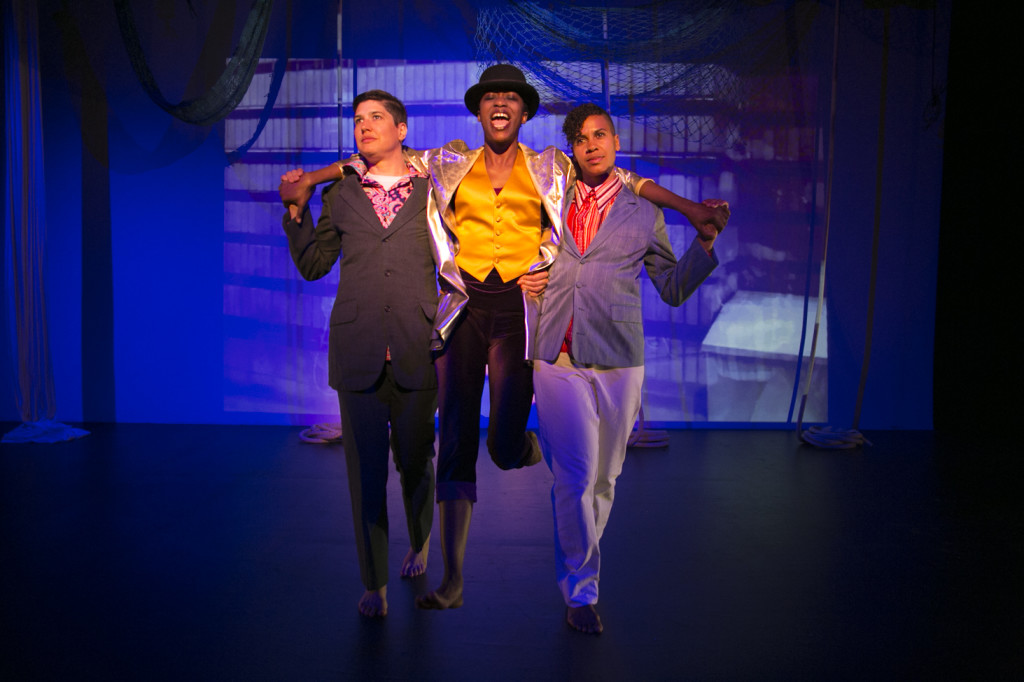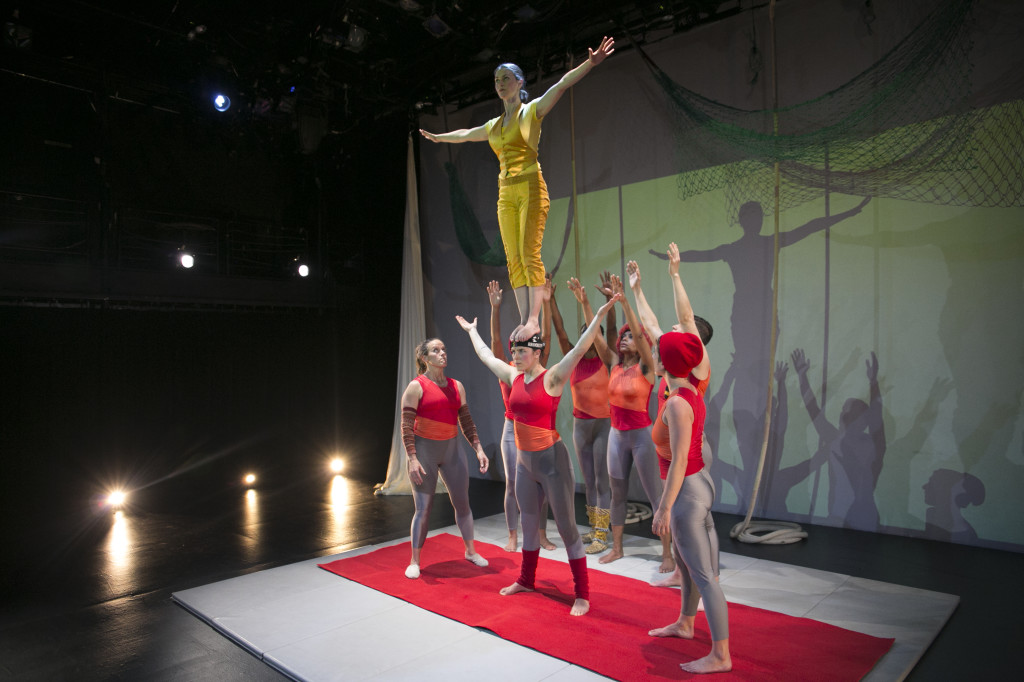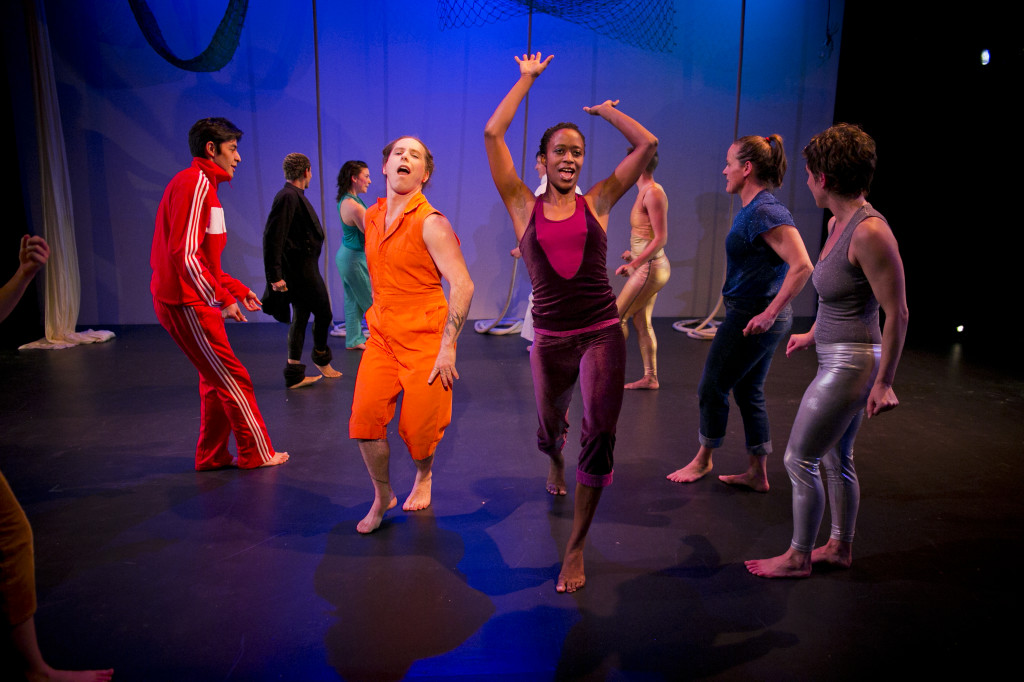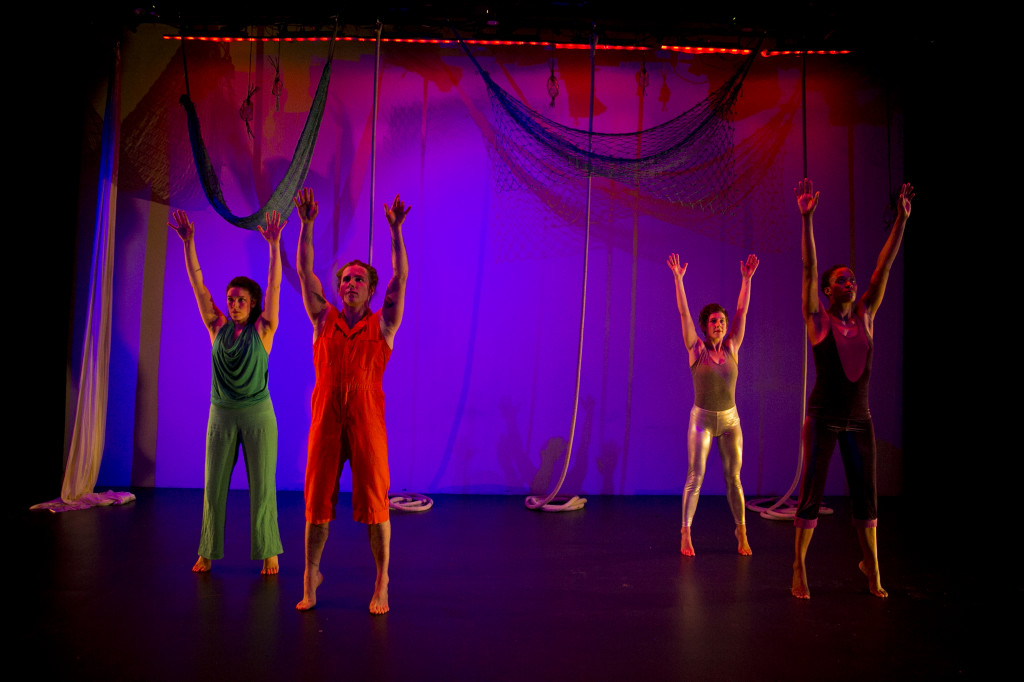Author | Sondra Fink
Photography by Whitney Browne
Sarah East Johnson rocks a handstand. She is the founder and artistic director of the dance/performance troupe LAVA Brooklyn. Like everyone else in the company, she can probably spring up into this pose at the bank or the grocery store. My own handstand is a daily attempt, but I still have to kick up against the wall. So I’m impressed.
“LAVA is more than a performance ensemble. It’s also a community centered on a performance aesthetic: the body, gender-ambiguous, strongly supported in impossible positions, daring, earth-moving positions, upside down and on its hands.”
My first encounter with LAVA was at a performance of their original work “Tracks” in 2014. I took my seat at Dixon Place with no idea what to expect. The show opened with a monologue, and I feared it would be “artsy”. I left about ninety minutes later minus my breath. Among many acts of pure strength and exuberant movement from rope-climbing to trapeze-dangling, I watched one human stand unsupported on top of just the physical head of another. As part of the performance, other company members spotted this act, eyes on the balanced human, hands in the air.
“That’s a piece called ‘Mountain’,” Sarah tells me at our meetup over lattes. “And in watching the training..that was where the idea for the piece came from, it was like, god, that is just so beautiful, we are really just here, like ‘I got you, I got you’.”
Sarah was one of the spotters in the piece. She’s got long auburn hair and the warmest smile, but her rock-solid stance, muscular arms and concentrated gaze evoke the Man of Steel. Her vision for the company began with an interest in geology and an understanding that the earth is constantly moving, “but on a scale that we don’t often get to witness. So it’s like this movement that is so basic, so essential and beyond us… but the results are astonishing. You know, volcanoes, mountains, oceans. And I like that lava is a liquid and a solid simultaneously. It’s creative and destructive simultaneously.”
I wonder what Sarah’s LAVA hopes to create and destroy. The company is all female and transgender, and there is a distinct political viewpoint in their movement which feels as challenging as it is joyous.
“I think ‘feminism’ still captures it,” she tells me, and she elaborates: “Within a feminist set of concerns are encoded race and gender and class, so that sort of then extends out to egalitarianism or anti-oppression work, trying to create ways of working and moving and training our bodies that can sort of undo some of the oppression of race and class and gender.”
She founded LAVA Brooklyn in 2000, her dream of a dance company combined with a studio. The company works together to create original artistic works combining dance, theater and acrobatics. They employ an athletic physicality that centers on their own bodies, but also incorporates bungee cords and harnesses, nets, trapezes, ropes and hoops. So I wonder: Is this serious business or is this fun?
“It was inspired by my work with Circus Amok,” Sarah tells me, “where we did political theater and traditional circus in city parks all around New York City… I started in 1989, and we were bringing really radical, gay political theater to neighborhoods where we didn’t know anyone, you know? Where the city was kind of bigger then, and going to the Bronx, and being, like, men in dresses and women with beards and hairy armpits and big muscles was really, uh…potentially threatening. But then you juggle and walk on stilts and people are smiling.”
LAVA performances may not rely on stilts or juggling, but there’s a carnival-style appeal in their virtuosic balance and raw physical strength.
“I think it’s another sort of attempt at deconstructing what I’ve found to be the limited oppressiveness of my dance training,” Sarah explains, “…a lot of girls in a big dance studio staring at themselves in the mirror and comparing themselves to the girl standing next to them and the girl standing in front of them and the girl standing behind them. And it was caustic. So, in working with an acrobatic vocabulary it totally subverts that setup, because you’ve got ‘well, you’re different from you, and that’s good because that means that you can stand on you.’”
The ensemble is diverse, and reflects Sarah’s vision of a dialog between individual and group, the importance of making space for individual expression and individual difference while still paying attention to the health of the larger family:
“Well, the fact that we have, you know, a white, gay woman who grew up in a comfortable class environment,” Sarah says, referring to herself, “like, okay, so as a woman and as a gay person I have experienced oppression, and as a white person and as a person who has never gone hungry, I have privilege.” Sarah acknowledges that the company leans in the direction of whiteness and in the direction of feminism. “But as our community grows,” she explains, “and as the sophistication of activism is growing…it feels like it’s really shifting forward…My sisters of color are doing a great job of helping me grow in my thinking about race. And I’m trying to understand the places of men and maleness in our community…I feel like the conversations are getting much more complex.”
“Do you have,” I ask hopefully, “any just run-of-the-mill straight women in your group?”
“Yeah!” she laughs. “I mean none of them are run-of-the-mill!” They may be hetero, but “I don’t think they identify as straight, and they certainly don’t move through the world as straight.”
Sarah tells me she’s been doing a lot of exploration into the expressions of difference that aren’t based on gender, starting with geology.
“There are two different kinds of rock,” she informs me, “oceanic rock and continental rock, moving around. They rub up against each other. Sometimes they explode and sometimes they flow and sometimes they emerge and sometimes they settle. I feel like that’s been really rich territory for me, and kind of thinking about our bodies as geology. It kind of gets us, like, pre-gender.…So how can we dial it back a minute? Because we’ve only been here for such a short time. Like let’s look at stuff that’s been around for billions of years.”
LAVA is more than a performance ensemble. It’s also a community centered on a performance aesthetic: the body, gender-ambiguous, strongly supported in impossible positions, daring, earth-moving positions, upside down and on its hands. Personally, I never encounter LAVA, whether at a performance, class or community event, without being seized by a relentless desire to express myself, a strange sense that someone just erased a bunch of outlines and more things are suddenly possible.
I found my way over to LAVA Studio to attend the LAVAlentines “Queer Prom”, and it took me an entire hour to realize I was the only person in the room wearing shoes. Whoops. Sarah feels the sense of “intersectionality” is an important element of the LAVA community, the intentional space of the studio bringing together of different “pockets of people”. So rather than scurry back into my own pocket, I quietly parked the shoes and hung around to enjoy the wonderful DJ Tikka Masala, Ballez and Heels on Wheels.
I made my way back to LAVA Studio to see “Night of Renegades”, works in progress by the company and friends, curated by company members Molly Chanoff and Ashley Brockington. I was sure to peel off my boots before slipping out of my coat, grabbing some wine, and perching on the edge of the folded up floor mats in the packed and noisy room. Sarah sat on the floor nearby in coveralls, a thermal tee and moccasins, directing an intense, kind focus on the proceedings.
Among other performances and presentations, company member Lollo Romanski looked like Clark Gable performing a counter-balancing trapeze duet with the ethereal Sarah Dey Hirshan to a recording of “You Don’t Own Me”. They wore shiny gold leotards and the routine was sexy. Molly Chanoff and Hilary Chapman improvised a dance duet to the improvised mouth noises of several others in the company. The dance was riveting, especially when a bright toddler wandered from the audience all the way into the performance area before s/he was plucked away by Lollo Romanski, now in a street shirt. The baby was innocently nervy, pink and gender non-specific. The baby just dialed it back a minute.
“Let’s break down some of these things that feel like they’re limiting us,” Sarah told me. “As a Californian, as a granddaughter of a pioneer…I really like offering new possibilities, you know? There’s a lot to be said to critique what’s happened so far, that’s just not where I tend to focus. I’m really excited about, like, ‘let’s try it. Let’s try this. Let’s see what happens if’.”
So If I keep kicking up against the wall, maybe one of these days I’ll finally hit that handstand.
LAVA is currently working on a new piece for their June 4th benefit which will take place at Littlefield in Brooklyn: “Mothers: Roots, Rocks and Matriarchs”. They will work with Dixon Place and The Flea Theater for their next New York season in 2016-17.





